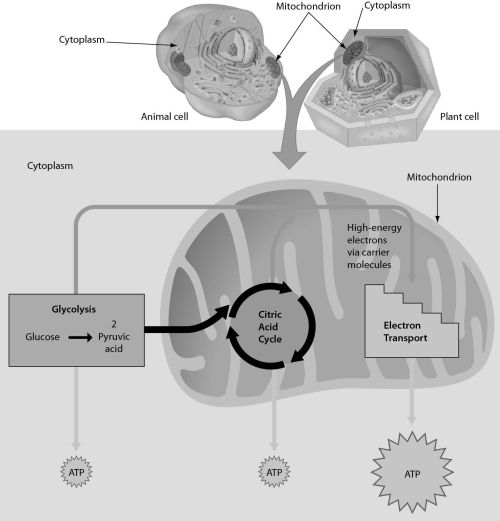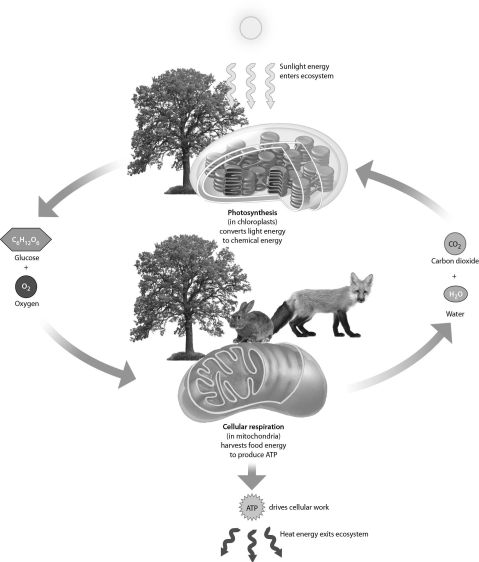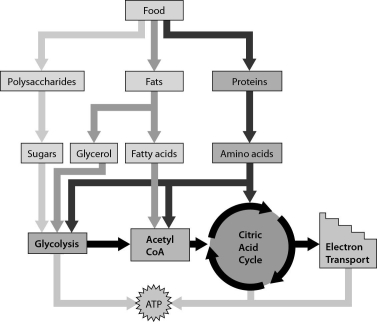A) the sun
B) producers
C) ATP
D) consumers
Correct Answer

verified
Correct Answer
verified
Multiple Choice
Examine the following figure.Which of these stages occur(s) in the cytoplasm? 
A) glycolysis
B) citric acid cycle
C) glycolysis and citric acid cycle
D) citric acid cycle and electron transport
Correct Answer

verified
Correct Answer
verified
Multiple Choice
Anaerobic respiration produces a maximum of ______ ATP per glucose.
A) 2
B) 4
C) 10
D) 38
Correct Answer

verified
Correct Answer
verified
Multiple Choice
The second stage of aerobic respiration is ______.
A) ATP production
B) the citric acid cycle
C) lactic acid fermentation
D) glycolysis
Correct Answer

verified
Correct Answer
verified
Multiple Choice
Which of these equations describes aerobic cellular respiration?
A) glucose → lactic acid + energy
B) energy + carbon dioxide + water → glucose + oxygen + water
C) glucose + oxygen → carbon dioxide + water + energy
D) none of the above
Correct Answer

verified
Correct Answer
verified
Multiple Choice
An aerobic process requires ______.
A) oxygen
B) carbon dioxide
C) ATP
D) carbohydrates
Correct Answer

verified
Correct Answer
verified
Multiple Choice
Human muscle cells use lactic acid fermentation to
A) produce more ATP than is possible through aerobic respiration.
B) produce ATP using the electron transport chain.
C) regenerate NADH.
D) produce ATP without O2.
Correct Answer

verified
Correct Answer
verified
Multiple Choice
Examine the following figure.Which of the following reactants primarily come(s) from the air? 
A) water
B) glucose
C) carbon dioxide
D) oxygen and carbon dioxide
Correct Answer

verified
Correct Answer
verified
Multiple Choice
During redox reactions,______.
A) the loss of electrons from one substance is called reduction
B) a substance that gains electrons is said to be oxidized
C) electrons are lost from one substance and added to another substance
D) protons from one molecule replace the electrons lost from another molecule
Correct Answer

verified
Correct Answer
verified
Multiple Choice
A product of glycolysis is ______.
A) lactic acid
B) ethyl alcohol
C) O2
D) pyruvic acid
Correct Answer

verified
Correct Answer
verified
Multiple Choice
Which part of cellular respiration produces the most NADH?
A) electron transport chain
B) citric acid cycle
C) glycolysis
D) Calvin cycle
Correct Answer

verified
Correct Answer
verified
Multiple Choice
Some friends are trying to make wine in their basement.They've added yeast to a sweet grape juice mixture and have allowed the yeast to grow.After several days they find that sugar levels in the grape juice have dropped,but there's no alcohol in the mixture.The most likely explanation is that ______.
A) the mixture needs more sugar; yeast need a lot of energy before they can begin to produce alcohol
B) the mixture needs less oxygen; yeast only produce alcohol in the absence of oxygen
C) the mixture needs more oxygen; yeast need oxygen to break down sugar to produce alcohol
D) the mixture needs less sugar; high sugar concentrations stimulate cellular respiration, and alcohol is not a by-product of cellular respiration
Correct Answer

verified
Correct Answer
verified
Multiple Choice
A horse eating some hay is an example of ______.
A) an autotroph eating a producer
B) an autotroph eating a consumer
C) a consumer eating a producer
D) a consumer eating a heterotroph
Correct Answer

verified
Correct Answer
verified
Multiple Choice
Which of the following is the correct sequence of stages in cellular respiration?
A) glycolysis, citric acid cycle, electron transport
B) citric acid cycle, glycolysis, electron transport
C) citric acid cycle, electron transport, glycolysis
D) electron transport, glycolysis, citric acid cycle
Correct Answer

verified
Correct Answer
verified
Multiple Choice
Which of the following are produced during cellular respiration?
A) ATP and water
B) carbon dioxide and ATP
C) carbon dioxide, water, and ATP
D) oxygen and glucose
Correct Answer

verified
Correct Answer
verified
Multiple Choice
A difference between marathon runners and sprinters is ______.
A) marathon runners have more slow-twitch fibers in their leg muscles
B) marathon runners have more fast-twitch muscle fibers in their leg muscles
C) sprinters have a high proportion of muscle fibers that require oxygen to make ATP
D) sprinters perform better in activities that require slow, steady muscle activity
Correct Answer

verified
Correct Answer
verified
Multiple Choice
The figure below shows that ______. 
A) amino acids can move directly into the electron transport chain
B) our cells can use sugars, fatty acids, and amino acids to produce ATP
C) our cells can produce ATP only from glucose
D) our cells can produce ATP from sugars and glycerol, but not fatty acids
Correct Answer

verified
Correct Answer
verified
Multiple Choice
Which of the following statements is true?
A) Oxygen is a product of cellular respiration; carbon dioxide is a product of photosynthesis.
B) Lactic acid is a product of aerobic respiration; ethyl alcohol is a product of fermentation.
C) Oxidation is the loss of electrons; reduction is the gain of electrons.
D) Glucose is a product of aerobic respiration; lactic acid is a product of anaerobic respiration.
Correct Answer

verified
Correct Answer
verified
Multiple Choice
The waste products of cellular respiration include ______.
A) water only
B) carbon dioxide only
C) water and carbon dioxide
D) water and glucose
Correct Answer

verified
Correct Answer
verified
Multiple Choice
What compound directly provides energy for cellular work?
A) C6H12O6
B) glucose
C) ATP
D) fat
Correct Answer

verified
Correct Answer
verified
Showing 21 - 40 of 43
Related Exams